By far, Loki’s most well-known children are the ones he had with the giantess Angurboda. These include the wolf Fenrir, the Midgard Serpent Jormugandr, and the goddess Hel. Legends say that the children were born in a dark cave in Jotunheim and the gods saw them as symbols of pain, sin, and death. The Aesir feared the potential of Loki’s three children so much that they bound Fenrir, cast Jormugandr into the great sea, and banished Hel to the underworld. Once there, Hel ruled the realm and Odin himself granted her power over all of the nine worlds.
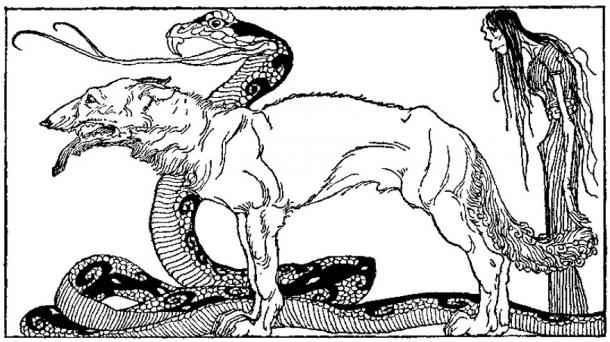
“The children of Loki” (1920) by Willy Pogany. ( Public Domain )
The Road to Hel
The goddess Hel was also thought to have power over all the dead, except the chosen slain who were taken to Valhalla. Similar to a certain extent to Svartalfheim, Hel’s realm also had underground dwellings and it could be reached after traveling a cold and rough road through the dark regions of the far North.
Legend says that even Hemrod had to ride Sleipnir for nine long nights to arrive at the entrance of the realm located beyond the River Gjoll. Originating from the wellspring Hvergelmir in Niflheim, River Gjoll flowed through Ginnunga Gap and then into the other worlds.
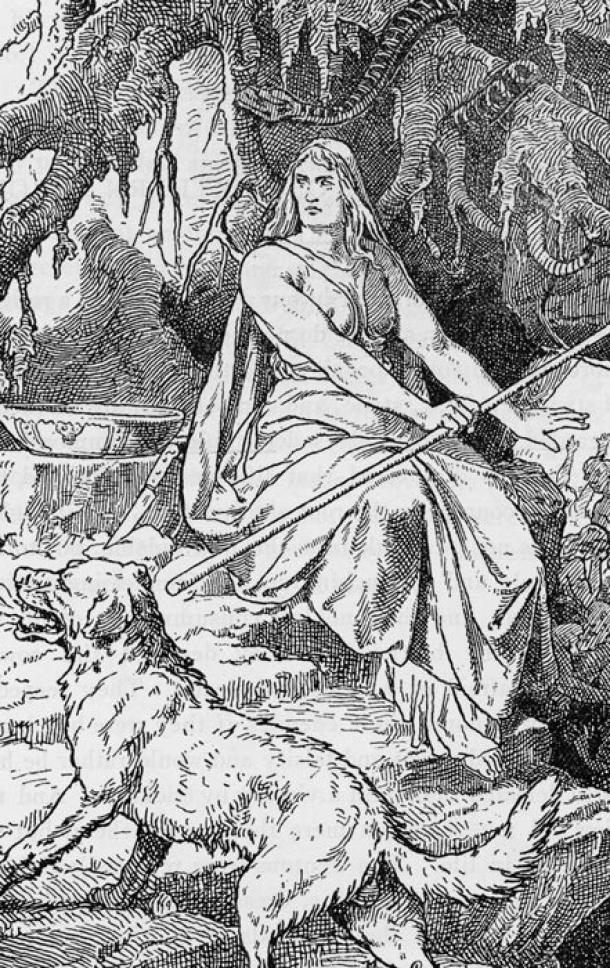
Hel, the Norse goddess of the underworld. ( Archivist /Adobe Stock)
In Hel (Helheim), the river flows close to the gate of the underworld, acting as a boundary. Gjoll also represents the name of the rock to which Fenrir is bound. As for the river itself, it is said to be freezing cold and it has knives flowing through it.
The only way to cross the river is over the bridge Gjallarbru, a crystal bridge arched with gold, which is hung on a single hair. The bridge is said to have a permanent guardian, the female skeleton Modgud. In order for the spirits to pass, they must each pay her a toll of blood. In “ Valhalla”, J. C. Jones describes the bridge as follows:
The bridge of glass hung on a hair
Thrown o’er the river terrible, –
The Gioll, boundary of Hel.
Now here the maiden Modgud stood,
Waiting to take the toll of blood, –
A maiden horrible to sight,
Fleshless, with shroud and pall bedight.
In order to cross over the bridge, the spirits made use of the wagons and horses that had been burnt alongside them on the funeral pyre. Also, the bodies of the dead were always equipped with Hel shoes, a strong pair of shoes specially designed to protect their feet throughout the journey over the rough road leading to Hel.
After crossing over the Gjallar Bridge, spirits reached Ironwood, a forest with iron-leafed trees. From here, they had to continue until they reached the gate of Hel. The gate was guarded by the fierce dog Garm. Garm dwelled in the dark Gnipa cave and the only way to appease him was to offer a Hel-cake. According to legend, these cakes never failed those who had given bread to the needy during their lifetime.
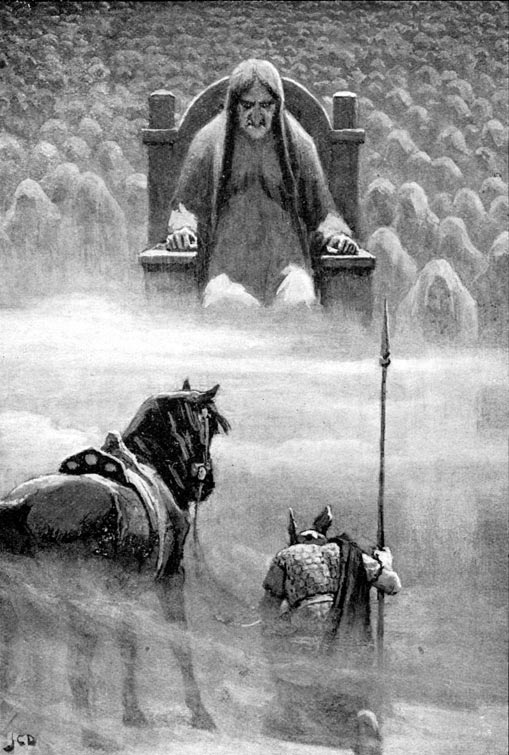
“Hemrod before Hel” (1909) by John Charles Dollman. ( Public Domain )
What is Hel Like?
After entering through the main gate in the cold and darkness, various sounds could be heard. These were the sounds of Hvergelmir, of the streams of Hel, and of the rolling of glaciers in the Elivagar. The streams of this realm included Leipter, where solemn oaths were sworn, and Slid, the river with swords within its waters.
The great hall of the goddess Hel carried the name Elvidner meaning “misery”. It was said that her dish was Hunger, her knife was Greed, her man was Idleness, her maid was Sloth, her bed was Sorrow, her threshold was Ruin and her curtains were Conflagration. J. C. Jones describes Hel’s hall as follows:
Elvidner was Hela’s hall.
Iron-barred, with massive wall;
Horrible that palace tall!
Hunger was her table bare;
Waste, her knife; her bed, sharp Care;
Burning Anguish spread her feast;
Bleached bones arrayed each guest;
Plague and Famine sang their runes,
Mingled with Despair’s harsh tunes.
Misery and Agony
E’er in Hel’s abode shall be!
Hel had different abodes for different people who entered the realm. Those going to Hel after death included criminals, perjurers, those who had the bad luck to die before getting a chance to shed blood, those who died of old age, and the ones who died of disease. Death of old age or of disease used to be called “straw death” as the beds of the time were made of straw.
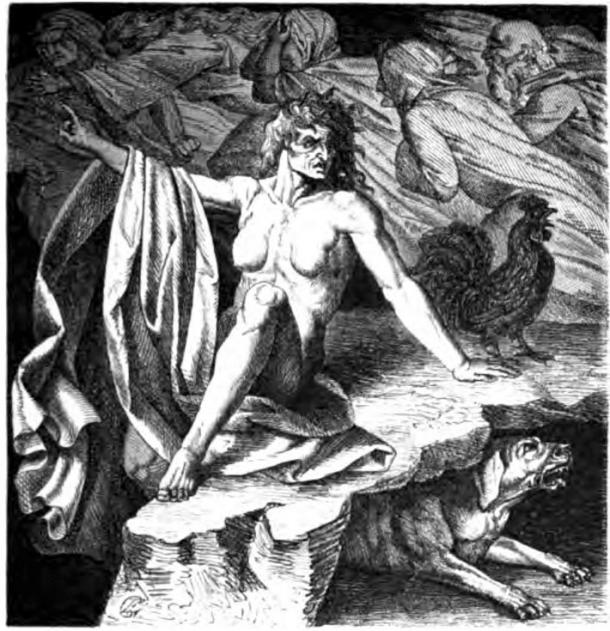
Hel (Carl Ehrenberg, 1882) and the dog Garm. ( Public Domain )
The Afterlife in Hel’s Realm and Nastrond
The innocent and those who had lived good and compassionate lives were treated kindly in Helheim. It can be said that they even enjoyed a type of negative bliss. However, Norse men and women preferred to live and die as warriors and join Odin’s chosen slain in Valhalla. When it came to the impure dead, like adulterers, murderers and oath-breakers, their spirits were banished to Nastrond.
This place had a cave of snakes and ice cold streams of venom. From this location, the spring Hvergelmir washed them down into Niflheim, where the dragon Nidhoggr used to constantly gnaw the root of the great world tree, Yggdrasil. The dragon would supposedly then pause his task in order to chew the bodies of the unfortunate impure dead. Thorpe’s translation of “ Saemund’s Edda ” describes Nastrond as follows:
A hall standing
Far from the sun
In Nastrond;
Its doors are northward turned,
Venom-drops fall
In through its apertures;
Entwined is that hall
With serpents’ backs.
She there saw wading
The sluggish streams
Bloodthirsty men
And perjurers,
And him who the ear beguiles
Of another’s wife.
There Nidhog sucks
The corpses of the dead.
Reaping and the Return of the Dead
Mostly the dead were believed to travel to Hel, but it was said that at times the goddess Hel herself liked to go reap the dead while riding on her three-legged white steed. Similarly, in other European myths the Grim Reaper is said to travel from one place to another on a white horse. Even in Christian mythology, Death rides a pale horse as one of the Four Horsemen of the Apocalypse .
During periods of famine or pestilence, when the inhabitants of a certain place died in large numbers, but some survived, legends say that Hel used a rake to reap the dead, while in cases when entire villages were depopulated, the underworld goddess supposedly reaped them using a broom.
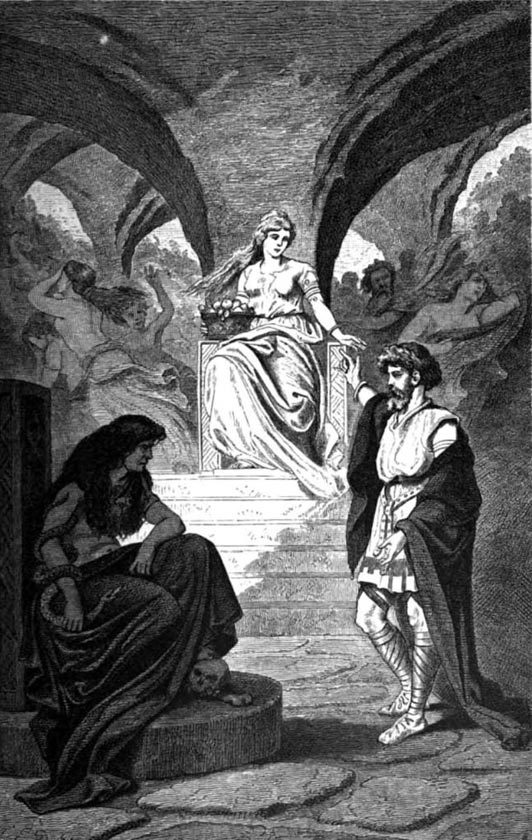
“Heimdallr desires Iðunn’s return from the Underworld” (1881) by Carl Emil Doepler. ( Public Domain )
Norsemen also believed in the return of the dead as ghosts for various reasons. In the majority of these cases, it was believed that the deceased used to return in order to convey certain messages.
Also, there was a common belief about the fact that the joy or sorrow of the living could influence the dead. The Danish “ Ballad of Aager and Else ”provides an example with a dead lover returning as a ghost to ask his beloved to stop grieving. In Longfellow’s translation, the passage goes like this:
Listen now, my good Sir Aager!
Dearest bridegroom, all I crave
Is to know how it goes with thee
In that lonely place, the grave.Every time that thou rejoicest,
And art happy in thy mind,
Are my lonely grave’s recesses
All with leaves of roses lined.Every time that, love, thou grievest,
And dost shed the briny flood,
Are my lonely grave’s recesses
Filled with black and loathsome blood.
Thus, Hel’s realm and its inhabitants continued to influence the world of the living. The goddess and her home lived long in Norse legends .
Top image: Hel is the Norse goddess of the underworld. Source: selenit /Adobe Stock
By Valda Roric
Updated on September 11, 2020.
References:
Valda Roric – “Loki – The Trickster Unleashed”
Valda Roric – “Loki – The Trickster Redeemed and the Secret of the runes”
Valda Roric – “Ancient Runes – Revealing the Future”
 RSS Feed
RSS Feed















 September 12th, 2020
September 12th, 2020  Awake Goy
Awake Goy  Posted in
Posted in  Tags:
Tags: 













